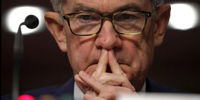Posted on March 03, 2022

By Paul Vanguard, for BullionMax.com
Everybody knows that, when interest rates go up, gold goes down. Investopedia will tell you about the “widespread popular belief is that there exists a strong negative correlation between interest rates and the price of gold.”
“Negative correlation” means they move opposite one another. Correlation usually ranges from 1 (moving in lockstep) to -1 (moving exactly opposite). And this is a widespread popular belief you’ll hear parroted on “investing” channels and podcasts.
The one small issue with this bit of popular wisdom is that it’s totally wrong. Remember the summer of '89? That was the last time gold didn't post big gains during an interest rate hiking cycle.
So not only is this popular wisdom wrong, it’s backwards. At least, usually. How can that be?
We can never overstate this simple principle: gold bullion price and demand is not the same as the spot gold price. Bewilderingly, even gold price fixers don't have that much of an influence on gold's price. (Honestly, the whole “How do gold prices work?” question is rather complicated – we explored it in greater detail previously.)
So what moves gold prices? Mostly, it’s over-leveraged speculators. And to call them merely over-leveraged, or even merely speculators, might be going just a little too easy. See, in the stock market, a trader can leverage their money by buying on margin. In most cases, you can double your impact, borrowing to exert twice the amount of influence on prices. That’s a maximum of 2x. Leverage and margin lets stock speculators act as if they own twice as many stocks. That doubles potential profits, and also exaggerates potential losses.
Precious metals are different. Paper gold investors have, somehow, been granted 31.3x the amount of price influence, more than 15x the leverage a stock speculator has.
In precious metals futures, a $6,000 investment can give you a contract worth 100 ounces of gold (at current prices). Note very clearly we’re not talking about actual ounces of physical gold – no, we’re talking about the rise and fall of paper that are distantly connected to gold’s price per ounce.
All that extra leverage, for speculators, it’s like catnip. Your gains are multiplied by 30! If you’re smart enough to make a $500 profit, that leverage turns it into $15,000. Ah, financial alchemy is amazing, isn’t it?
That’s how we get into speculation.
Just to be clear, we’re distinguishing between investors and speculators based on Benjamin Graham’s definitions established in The Intelligent Investor (probably the best book ever written on investing). In summary:
Here’s why all that is relevant.
We know that traders price in rate hikes well in advance and in succession. When that happens, spot gold price tends to take a beating. Traders are betting on gold to underperform due to those rate hikes, and, thanks to that 31x leverage we mentioned, push the price down with their wagers. Despite this,gold still historically comes out on top by the end of the rate hiking cycle.
Which rate hiking cycle do we sample as an example dating back more than 30 years? Well, take your pick!
The latest one ran between 2015 and 2018. It destabilized the bond market with nine rate hikes. Doesn’t that sound absolutely apocalyptic today? Wall Street’s convinced that, today, the U.S. can’t withstand a 225-basis point increase. Well, gold gained 17% during that 2015-2018 rate hike period.
Consider the two-year rate-hike cycle of 2004 and 2006, with 17 increases, a total of 425 basis points. Gold investors (note – not speculators) enjoyed a 49.6% gain.
While there isn't exactly a precedent for today's economic conditions, we're hearing them compared to the inflationary 1970s over and over again. And what did gold do after the Federal Reserve printed massive amounts of money and consumer prices exploded? By the time the cycle was capped in 1979, gold gained 178.3%.
It wasn’t all roses, though. In the four times that gold did post losses during rate hike cycles dating back to 1971, the average loss was 10.5%. Nothing to get crazy over, and really quite modest compared to any of the gains, isn’t it?
The economic conditions during these hike cycles were practically irrelevant to present-day ones. The more inflation there is in the mix, or the greater the recessionary risk, the greater are gold's gains. And this cycle, should it indeed materialize as promised, has plenty of inflation and recession risk.
So, why are interest rate hikes considered bad for gold? Ill intent aside, is it such a stretch to say that everyone involved simply didn't, you know, check their data?
Since there’s no crystal ball providing secrets from the future, the best we can do Is take a look at the past. Should this rate hike cycle follow the pattern, there’s a little possible downside and a whole lot of upside ahead.
Paul Vanguard is a lifelong precious metals enthusiast and a proud member of the BullionMax team.